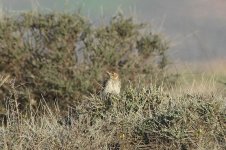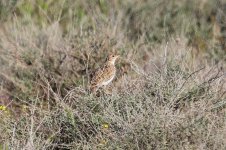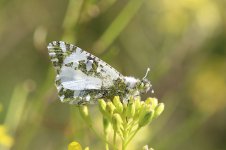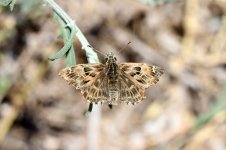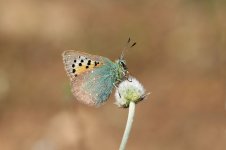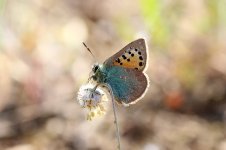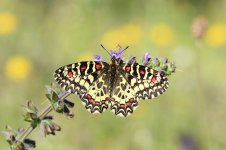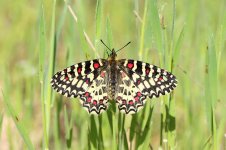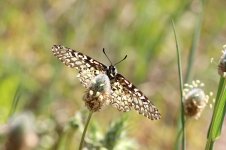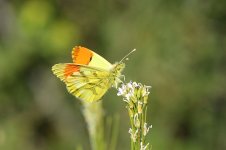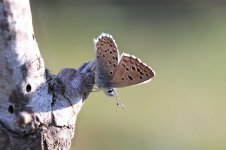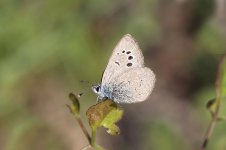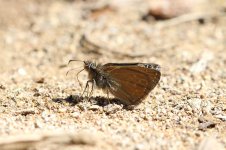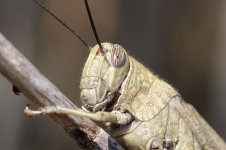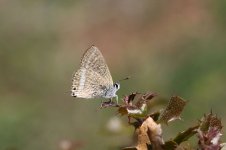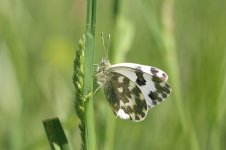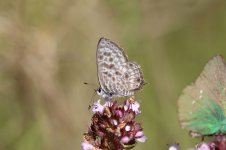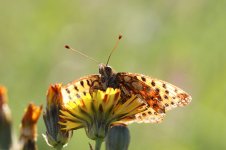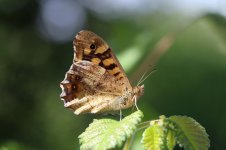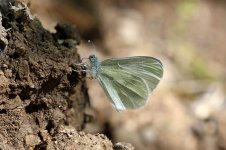10 April. Jaffre & Montgri.
A shift of location this day, moving 250 km north of the Ebro Delta to the Girona region. And with the kilometres rolling by, so the landscape became ever greener and ever better for butterflies.
First stop this day was in a quite splendid setting near the small town of Jaffre, an area of open alluvial forest, ox bows and meadow patches in a meander of the Ter River. Had identified this area via satellite maps, but had high hopes that it might produce Spanish Festoon, my main target of the trip. Got there a little before 10 a.m., a warm sun already taking the temperature up over the 16 C mark, Cetti's Warblers in the rank stuff, Wryneck and Golden Oriole singing from the pines, the plaintive calls of a daytime Scops Owl also gently floating across. A couple of Hoopoes flopped up from sandy tracks, two Bee-eaters adorned a snag above an old meander loop.
No butterflies flying on arrival, but it took all of five minutes to find my first ...and what a corker it was, exactly what I was looking for, a superb Spanish Festoon sunning on a flower stalk! And then I found another! All too soon, as the temperature continued its upward path, more and more butterflies began to appear, amongst them plentiful Spanish Brown Arguses and Common Blues, a couple of dozen Green Hairstreaks, the occasional Clouded Yellow, a dozen Small Heaths and a Queen of Spain Fritillary.
Also added my only Small Copper of the trip, plus both Large and Small Whites, a Red Admiral and a couple of Painted Ladies. Best of the lot however, loads of Spanish Festoons, at least 30 in all, mostly preferring slightly damper areas with flowers. Truly nice. And as a perfect compliment, several Swallowtails and quite a few vivid Cleopatras too.
Spotless Starlings, Crested Tits and Wood Larks also present, it was really a pleasant couple of hours here. Early afternoon I finally departed, driving a half hour or so to the beachside Gola del Ter, my base for the next few days. Dumped my stuff in accommodation and backtracked a little to Montgri, an impressive limestone massive that towers above the town of Torroella de Montgrí.
Pleasant 25 C now, I zigzagged through the backstreets of Torroella de Montgrí to try and find a suitable route to tackle the slopes above. First stop, meadows adjacent to olive groves, wasn't too bad at all - a few Swallowtails in flight, my second Provence Hairstreak of the trip, plentiful Speckled Woods, a couple of Cleopatras. No easy access to the higher slopes from this point, so continued a little to the west and stumbled across an excellent track that led to the Santa Caterina hermitage and cut through excellent habitat on the way. Three main targets here, namely Provence Orange Tip (a recent split from Morocco Orange Tip), Black-eyed Blue and Panoptes Blue. The first proved easy enough – from olive groves at lower altitudes right up towards the hermitage itself, occasionals of these dainty yellow and orange butterflies graced the slopes, very rarely settling however. Alongside, standard Orange Tips were also on the wing, along with plentiful Green Hairstreaks, Speckled Woods, Clouded Yellows, Cleopatras and both Common Blue and Spanish Brown Argus. Also a couple of Holly Blues, a Lang's Short-tailed Blue, a Mallow Skipper, a couple of Red Admirals and two Painted Ladies. As for the rarer blues however, it took a lot of searching – failed to find a Black-eyed Blue, but eventually located the quaint Panoptes Blue, a single individual on short turf near a clump of pines.
At the hermitage itself, quite a few whites drifting around, several Bath Whites amongst them, but rarely did the smaller whites settle to allow confirmation if Southern Small Whites were present ...one for the next day!





